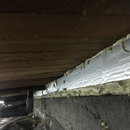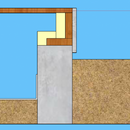Crawlspace Rim Joist Insulation
Climate zone 3C (95062, coastal California).
My primary concern is not rotting out my rim joist.
I’ve been slowly retrofitting my single-level home’s crawlspace. Starting with a traditionally vented crawlspace, I’ve added a vapor barrier on the ground, extending up 3-4″ on the concrete stem wall. Vents have been closed and a dehumidifier is used in the summer. A radon fan also runs which currently vents the entire crawlspace at a very low CFM which someday will be ported correctly below the vapor barrier.
On the exterior of the home, the stucco runs all the way down the wall and is buried in the dirt. I’ve been cutting this back so it is no longer in contact with the ground but haven’t finished the entire home yet. I can get at least 1.5″ of air space between the stucco and the dirt in most places (although some directly touches a patio slab and garage slab). I’d like more than 1.5″ but this is already after some significant (to me) earth moving to achieve this. No weep screed but I figure it’s better than being buried.
I am now insulating the rim joist with 2″ of polyiso and spray-foaming it into place.
There is no water control layer on the exterior of stem wall. I also do not believe there is any separation between the stem wall and wood sill plate.
Humidity levels in the crawlspace hover 40-50% RH in winter and are maintained at 60% in the summer.
How worried should I be about rotting out my rim joist? My main fear is the stem wall slurping up moisture and transferring it to the wood.
A picture and detail are attached.
GBA Detail Library
A collection of one thousand construction details organized by climate and house part











Replies
Giving my question a bump.
Steve,
This same question gets asked regularly on GBA, and unfortunately the answer is we don't know where that point is on existing houses with vulnerable rim-joists when limiting drying and allowing them to stay colder leads to decay. It's dependant on so many variables I don't think anyone can give you a definite answer either way.
Hi Malcolm,
Yeah, that's totally understandable and I've gotten similar responses (or lack thereof) on other moisture-related questions. Any feedback is appreciated even if they come with big asterisks.
Steve,
My friend in cold but very dry Calgary successfully did it in very similar circumstances, I wouldn't here in the Wet PNW, but don't know enough about what coastal California is like to venture a guess.
In a climate that isn't that cold, and being risk adverse, I would probably just diligently air-seal and leave them un-insulated.
The safe bet is to follow one of the paths outlined in the code books.
One you have rejected is vented.
The others are designed to condition the crawlspace and keep it more or less the same temp and humidity as the rest of the home.
The way I see it the humidity number is not the problem The dew point number is the important number and does any surface in the crawlspace ever get colder than the dew point of the air in the crawlspace. If that happens things get wet the question becomes how wet and how long before it dries out.
Understand what you are doing is a code violation and is risky. What you are doing may well work for your house in your climate but it will not work for every home in every climate.
The safe play is to heat and cool the crawl space to more or less the same temp and humidity as the rest of the home.
Walta
Walta,
I believe you are concerned that my crawlspace is too wet. My main concern is specifically my rim joist. I've attached my relative humidity and dewpoint numbers from the crawlspace (I have a sensor there). It seems like a pretty nice place to be. I'm actually more concerned that by isolating the rim joist from the nice crawlspace, I'm taking away one of the two directions the rim joist can dry to. Is this a valid concern and does it change your answer?
I'm also curious about what part of my setup is a code violation. I have a dehumidifier.
Based on these responses so far I believe I'll be scrapping off all my work which is sad. I should have asked before.
P.S. the random spike in RH in June is when the house had no power and therefore no dehumidifier running. Anything red on the RH graph is >60%.
Giving this one last post for visibility...if anyone has any light to shed on this its appreciated before I grudgingly rip it all out.
In terms of rim joist health the interior air is far less important than having a capillary break between the concrete and the wood. Untreated wood should never be in contact with concrete that is in contact with the ground.
Ok sounds like another vote for rip it out to be safe. The wood is untreated but at least the house was completely framed in redwood.
Do not rip out anything just to be safe. Assess the condition and replace if required.
Short of crawling down there every 2 months and testing several spots of the rim joist with a moisture meter....any suggestions?
One last Friday bump for visibility then I'll leave you all alone. I do appreciate the responses.
I have a nasty crawlspace under the older part of my house, and if I am not down there for other reasons I will put on the coveralls and have a look once per year, just to make sure nothing out of the ordinary is happening.
Once or twice a year is completely sufficient for inspecting your crawl unless conditions are very bad.
If you are changing conditions with the addition of various layers, and you are concerned about future performance, then you might want to check more frequently until you get a feel for what is happening.
I would be concerned with capillary water movement from the foundation wall into the mudsill and rim joist. It's a lot of work but you could address that problem by jacking up the floor joists and mud sill 1/4", one section at a time, and slipping in an impermeable layer such as metal flashing or a flexible butyl or bituminous membrane.
I just reviewed your photos and see that you have already encapsulated the rim joist area. You probably don't want to rip it out, so at this point I'd either cross my fingers or pray.
I have always liked thin (1/32" to 1/16" thick) HDPE sheet for this kind of capillary break retrofit. HDPE is rigid, fairly stiff, and slippery, so it's much easier to slide into a small gap than something more floppy like EPDM roofing membrane.
What I've done in a few situations like this is to apply Coppercoat to the accessible side of the rim joist and mudsill. Coppercoat is a sort of paint-on treatment a little bit like what is used for pressure treated lumber, but you'll never get it "in" the wood the way the pressure treating process can. Coppercoat provides a LITTLE additional protection against rot. I then use EPS to insulate the rim joist since EPS is the most vapor open of the common rigid foam materials, so it provides a LITTLE drying ability to help keep moisture levels in the wood from staying high perpetually.
You really need a capillary break though, and having used completely vapor impermeable foil faced polyiso, you're in a sort of worst-case scenario here. Whether you replace it or not is up to you, but keep in mind that severe damage to foundation related parts of the home can mean expensive repairs in the future.
Bill